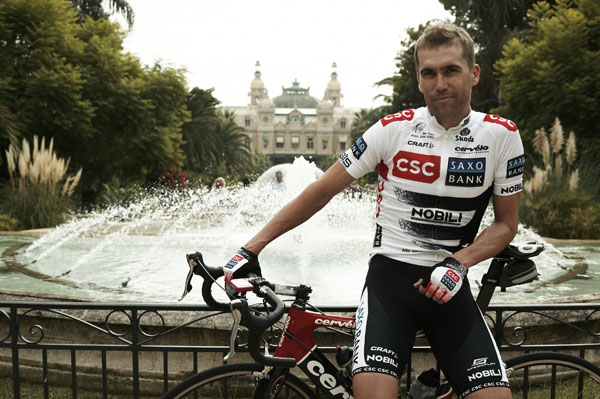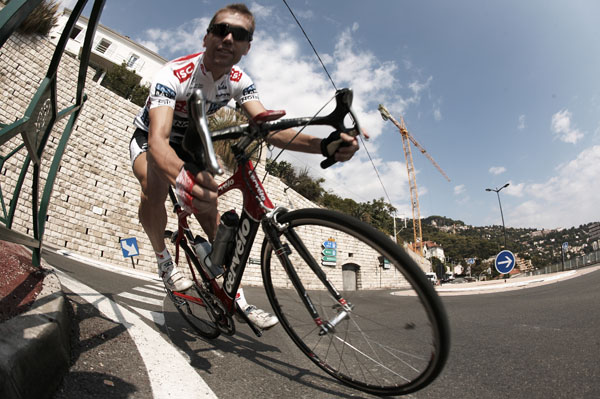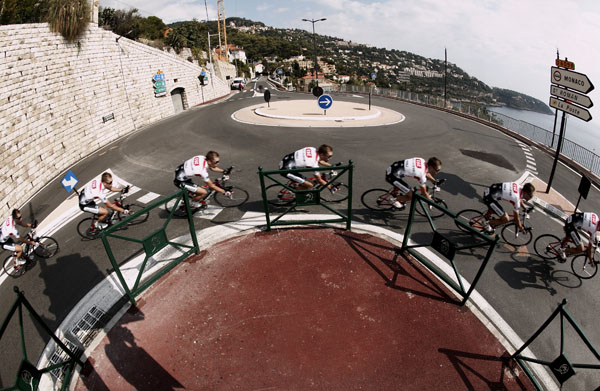Monaco TT reconnaissance with Brad McGee

This feature originally appeared in the December issue of Cycle Sport.
Wherever you look in Monaco there is an obvious sign of wealth. It’s not necessarily ostentatious, not always deliberately showy, there is just a sense that everything costs. Whether it’s the supercar idling luxuriously at the traffic lights, the bespoke high heels clicking on the pavement, or the absence of prices on the menu outside one of the smart restaurants on the beachfront, there is nothing cheap about the place.
It is part of the Tour de France’s unique charm that next July it will be able to settle in alongside the millionaires’ yachts in the port just as comfortably as it did among the farmers’ fields in Brittany earlier this year.
As London did two summers ago, Monaco will put the ‘grand’ in Grand Départ. The principality is independent from France and spans an area of less than a square mile.
It is not a nation, rather a very well-heeled, autonomous city, perched on the rocky cliff above the Mediterranean. Much of its eclectic architecture betrays the period of rapid development in the Fifties and Sixties and gives you the feeling you have walked onto a film set from the early days of colour cinematography.
There is a classic chic about the place and a sense that it takes more than just a large number in your bank account to fit in.
Along the coast, spanning from the harbour down to Monte Carlo beach, are wide Parisian-style boulevards, but further up the hill the roads are narrow and twisty. Streets are stacked on top of each other as if craning for a better view of the bright blue sea or one of the huge liners crammed with holidaymakers waiting to dock.
Get The Leadout Newsletter
The latest race content, interviews, features, reviews and expert buying guides, direct to your inbox!
The high-rise apartment blocks have even higher price tags, with rents escalating dramatically if your balcony is high enough and facing the right way to have a view over the bay.
Last summer, Brittany, arguably French cycling’s spiritual home, extended a warm, fanatical, but engagingly humble, welcome to the Tour. You can’t get much more of a contrast to that than Monaco.
It is at the other end of the spectrum. It is testimony of the Tour’s appeal that it can span the earthy reality of Brest to the polished luxury of Monte Carlo. From tractor wheels to roulette wheels but all the while retaining its innate sense of self. They say the Tour de France embraces and engages the rich and the poor alike, sparking a buzz of excitement among the sophisticated as well as the down-to-earth, and it’s true.
When you consider that Monaco plays host to the moneyed circus that is Formula 1 on an annual basis, perhaps the Tour will not have such an impact on the city. Maybe it won’t dominate the landscape during the week leading up to Grand Départ weekend to such an extent. There may not be such a sense of occasion among the locals, but for the Tour, Monaco adds prestige by the jeroboam.
London raised the bar, with more than a million spectators lining the streets for the 2007 prologue. However, there are less than 30,000 residents in Monaco, and even with holidaymakers heading in from the other towns on the Cote d’Azur such as Nice, Grasse and Menton, it is hard to imagine too many trekking up onto the moyenne corniche road for the afternoon.
There is no doubt Monaco will get the Tour off to a spectacular start, using part of the Formula 1 circuit and passing the famous Monte Carlo Casino guarantees that. It will also add a dash of glitz and glamour that, with the best will in the world, no number of cows wearing polka-dot jerseys made of bed sheets on the Breton farmscape can match.

Above: the Monaco course is more techincal than many thought it was going to be
The city is vibrant, opulent, photogenic. No doubt the television directors are already salivating at the prospect of taking long lingering shots of the yachts or Charles Garnier’s palatial casino or the pretty, rich faces enjoying a glass of Champagne by the sea.
But when the riders start to roll down the start ramp, it’s as if the surroundings melt away. All that matters then is the course and the gradient, the corners and the hidden difficulties will all come into play. So, what is the course for the stage one time trial actually like? We went to find out.
Cycle Sport meets Bradley McGee at a café in Cap d’Ail, a short ride up the coast from his home in an apartment block overlooking Larvotto beach, at the Monte Carlo end of the bay in Monaco. The 32-year-old Australian and his wife Sharni live there with their two young children. McGee was born and brought up in Sydney. Since moving to France as an amateur cyclist he has made his home in Angers, western France, then Toulouse, the studenty city in the south west, then Nice, and now in Monaco.
McGee is the perfect guide to give us a first-hand tour of the course. His finest hour came in Paris in 2003, when the centenary edition of the Tour de France started in the capital. That day he won the prologue and wore the yellow jersey.
As one of the superb generation of Australian track riders who transferred to the road, McGee was always well suited to prologues and short time trials. On his Tour de France debut in 2001, he was 12th in the prologue at Dunkirk, 11th in Luxembourg the following year, and fourth in Liege the year after his victory in Paris. He missed London through injury but when it was announced that his European home was to host the start of the 2009 Tour, he was excited.
However, between setting up the trip to Monaco and arriving to meet McGee, his career had taken a dramatic turn. A late-night phone call from his boss at CSC, Bjarne Riis, had persuaded him call time on his racing career and become a rookie manager. Although he’d already agreed to race for one more year with Saxo Bank, Scott Sunderland’s departure to Cervélo meant a vacancy in the managerial department. McGee fitted the bill and had no hesitation in saying yes.
“When I looked at what I wanted to do next year, that prologue was one of the big objectives, so yes, I will miss it. It was a bit of a pull in the opposite direction, but not enough to turn down a chance to become a director,” he says over coffee.
“To stay a bike rider was an option, and that was what I was going to do until Bjarne called. But with the offer of a chance to start a managerial career on the table, a prologue in Monaco wasn’t enough. I am sure on the day I will have a tinge of regret, but there are no guarantees I’d get in the team.”
McGee finishes his coffee and suggests we follow him down to Quai Albert 1er next to Port Hercule. The port itself is crammed with pristine yachts from the recent Monte Carlo yacht show and the three-lane road is as busy as any in a major city. There is one difference here, though. As well as the standard road markings, there are also the large white boxes that indicate the Formula 1 grid positions.
The time trial is not technically a prologue because at 15 kilometres, it is too long to meet the UCI’s definition. Incidentally, this also means Carlos Sastre will not wear a yellow jersey for the stage. And it starts right here, on the grid. To say that the opening minute or so of the course will be a shock to the system is an under-statement.
“You get a lot of people asking what it’s going to be like. I’ve explained to a few riders that it’s going to shock a few. I think people are going to have to come down here and see it for themselves,” says McGee.
There are less than 200 metres of flat road before the climbing starts. In essence the course is 7.5 kilometres up, followed by 7.5 kilometres down, and the key is going to be measuring the effort early on and leaving enough in the tank to attack the final 2.5 kilometres after the descent, along the Avenue Jean Jaures, past the Monte Carlo Country Club and back into the harbour at La Condamine.
With so little time to get into any sort of rhythm, the first section of the hill could ruin any chance of a good time. The 500-metre section at an average gradient of six per cent takes the riders up to the famous Monte Carlo Casino, where it levels out before sweeping past the railway station and then beginning a more concerted climb across the border and into France.
“There’s so little chance to get it going. There’s no time to gain any momentum to take into the first rise. It’s just round the corner and boom, you’re climbing,” says McGee.
At the casino, we encounter our first problem and have to take an adjacent road. For a start, the time trial course will take the riders the wrong way up a one-way street. The road is guarded at each end by a white-shirted member of Monaco’s police force, to protect against any movie-style raid on the casino.
“You’re not allowed down that road on a bike or a scooter,” says McGee. “And you’re not allowed to photograph the casino either. I’ve tried to call a couple of friends in the police but couldn’t get permission.”
We’re not coughing up for bail in one of the most expensive cities in the world, so McGee takes a detour, pointing at where the race route will emerge.
As we join the Boulevard Jardin Exotique, the Garmin tells us we’re already 100 metres above sea level and we’ve only covered 2.5 kilometres. We’ve covered the steepest part of the climb, where a tight hairpin bend at the extreme south-western end of the course has brought McGee onto the Moyenne Corniche, the middle of three coastal roads which runs parallel to the Monaco border.
“The real climbers are going to like the first half of this course,” McGee says. “The climbing is relentless until you get up onto the Moyenne Corniche. It’s going to take so much good execution on the climb to ensure you don’t blow before the top.
“But if they can’t defend what they gain on the descent, they’re in trouble.”
Still the road rises until we reach the town sign heralding McGee’s arrival in Beausoleil. The high point of the course comes 7.2 kilometres into the race and is at 228 metres. To our right the Mediterranean shimmers and the pale cream walls and rooftops of Monaco look stunning.
The descent is underway, McGee tucks in, takes the corners smoothly. A tight right-hander around 6.5 kilometres from the finish is the first tricky corner to negotiate. The road so far, though rutted in the gutters and dotted with uneven drain covers, is smooth and fast.

Above: McGee descends through a tight corner
McGee says: “It’s going to be a super-fast descent. It’s long enough for the good descenders to really make time up over those who are not so good.”
With four kilometres to go, the road is plummeting downwards when a right-hand U-turn smacks us right in the face.
It’s a roundabout on a blind corner. A line of houses in the triangle between the upper and lower road makes it impossible to look through the corner. A strip of raised tarmac impedes the racing line and, unless it is removed for the race, will force riders to slow down even more than they normally would. McGee shows us the racing line, slowing considerably, easing out into middle of the road, weight back, almost flicking the front-end into the corner before releasing the brakes and swooping through the corner.
“I reckon they should leave the barriers open because that corner is easy to get wrong. There are going to be some guys who hit it too fast,” he says.
“That corner really takes the pace out of the descent just as you are coming to the flat run-in.”
Back on the flat, past the Monte Carlo Country Club and the Larvotto beach, past the huge, imposing hotel that is likely to be the home for the teams during the build-up to the Grand Départ and then back onto the familiar Grand Prix circuit for the final 1,500 metres. A short stretch through the famous tunnel takes them back to the harbour.
It’s tempting to think of the course as half uphill and half down, but the final, flat 2.5 kilometres will test whether the riders have judged the race correctly.
“That final couple of ks is too long to bluff it,” McGee says. “It’s a long way and you’re going to need plenty left to make the most. If you’re fading there, you could lose a lot of time.
“It’s going to be really interesting to see what sort of bike rider comes out on top.”
NOTHING LIKE IT BEFORE
As an opening time trial, the Tour has never seen anything like it. When the Tour de France organisers revealed that the 2008 Tour would do away with the opening time trial for the first time in 40 years, Christian Prudhomme promised it would be back in 2009.
But anyone expecting a standard city centre test is in for a shock.
The hilly time trial in Monaco will not be the first time the Tour has shunned the traditional prologue of between five and ten kilometres on the opening day:
2008 – road stage
Brest to Plumelec
197km
Winner: Alejandro Valverde
2005 – longer time trial
Fromentine to Noirmoutier en l’Ille
19km
Winner: David Zabriskie
2000 – longer time trial
Futuroscope
16.5km
Winner: David Millar
1988 – preface
Pornichet-La Boule
1km
Winner: Guido Bontempi
1971 – team time trial
Mulhouse
11km
Winner: Molteni
WHO WILL WIN?
“To me, it’s got Cancellara written all over it. He’s got the power for the climb, if he’s in his best condition,” says McGee.
“You are going to need to be a good climber and a good descender, so perhaps someone like Contador or Valverde will have a chance. It certainly brings the GC riders into play a lot more than the usual six or seven-kilometre prologue.
“Having said that, a good descent could counter any losses on the climb so maybe someone like Hushovd?”
So, will it be a case of holding back on the climb?
“I still see it as an aggressive course. It’s not a defensive course at all. You have to attack the first half with everything and then hope to recover a bit on the descent. The descent is steep in places so there will be a chance for the legs to recover a bit.”
The descent is a little like that of the Poggio at the end of Milan-San Remo, although it is less technical. “You’re going to have to power out of the corners. Someone like Fabian gains time out of those corners.
“The key will be that final bit on the flat. Who can turn it on there and really squeeze the most out of themselves. The biggest thing is that the job is far from done when you get back down onto the flat, there’s still a lot of riding.”
WHAT ELSE IS THERE TO DO IN MONACO?
If you are lucky enough to get to Monaco for the Tour’s opening weekend, what else is there to do? We asked Brad McGee…
Visit the casino
“I’m not really much of a gambler, but I have been in there and it’s an amazing building. Definitely worth a visit.”
Eat well
“There are a lot of nice restaurants, but not everywhere is really expensive. You can get a very good but pretty inexpensive meal.”
Star spotting
“I am kind of used to seeing famous people now. You do see a lot of famous faces but whenever someone asks me to name them, my mind’s a blank. I think the appeal for a lot of famous people is that no one stares at them. If you are rich and famous you can turn the corner and see someone richer and famous. If you have a really exclusive car, you see the next guy and he owns the dealership that sold it to you.”

Thank you for reading 20 articles this month* Join now for unlimited access
Enjoy your first month for just £1 / $1 / €1
*Read 5 free articles per month without a subscription

Join now for unlimited access
Try first month for just £1 / $1 / €1
Sports journalist Lionel Birnie has written professionally for Sunday Times, Procycling and of course Cycling Weekly. He is also an author, publisher, and co-founder of The Cycling Podcast. His first experience covering the Tour de France came in 1999, and he has presented The Cycling Podcast with Richard Moore and Daniel Friebe since 2013. He founded Peloton Publishing in 2010 and has ghostwritten and published the autobiography of Sean Kelly, as well as a number of other sports icons.
-
 'It took everything' - Puck Pieterse outclimbs Demi Vollering to win La Flèche Wallonne
'It took everything' - Puck Pieterse outclimbs Demi Vollering to win La Flèche WallonneDutch 22-year-old shows Classics pedigree with first one-day victory
By Tom Davidson
-
 Tadej Pogačar flies to dominant victory at La Flèche Wallonne
Tadej Pogačar flies to dominant victory at La Flèche WallonneSlovenian takes second win at Belgian classic ahead of Kévin Vauquelin and Tom Pidcock
By Tom Thewlis